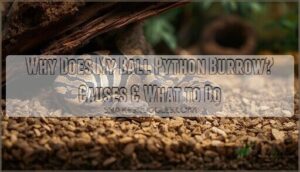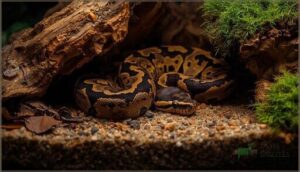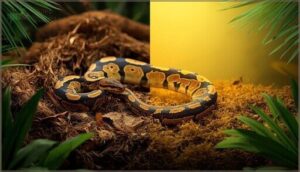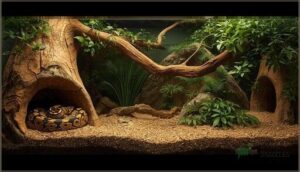This site is supported by our readers. We may earn a commission, at no cost to you, if you purchase through links.
You might notice your ball python constantly digging under its water bowl, pushing itself beneath the substrate, or wedging into the tightest corner of its enclosure. This burrowing behavior isn’t random—it’s a hardwired survival instinct inherited from wild ancestors who spent their days hidden in abandoned rodent burrows and termite mounds across West African savannas.
In captivity, your snake still carries this deep-rooted need for concealment and security. While some burrowing is completely normal, excessive digging often signals that something in your setup isn’t quite right—whether it’s temperature gradients, humidity levels, or inadequate hiding spots that leave your python feeling exposed and stressed.
Table Of Contents
- Key Takeaways
- Why Does My Ball Python Burrow?
- Normal Burrowing Behavior in Ball Pythons
- Environmental Factors Affecting Burrowing
- Common Reasons for Increased Burrowing
- Substrate and Enclosure Setup Considerations
- Health Implications of Excessive Burrowing
- How to Address Problematic Burrowing
- Frequently Asked Questions (FAQs)
- Why is my ball python burrowing?
- Do ball pythons like to burrow?
- Why is my ball python burying itself in the substrate?
- Do ball pythons bury themselves?
- Why is my ball python soaking a lot?
- What happens if your ball python is too dry?
- Is it normal for my ball python to burrow?
- How do I know if my ball python is unhappy?
- Why does my snake keep digging?
- What does it mean when a snake burrows?
- Conclusion
Key Takeaways
- Ball pythons burrow because of hardwired survival instincts from their wild ancestors, who spent most of their time hidden in rodent burrows and termite mounds for protection and thermoregulation.
- Excessive burrowing usually signals environmental problems in your setup—specifically inadequate temperature gradients (should be 88-92°F warm side, 75-80°F cool side), humidity issues (maintain 50-60%, rising to 70-75% during shedding), or insufficient hiding spots that leave your snake feeling exposed.
- While normal burrowing involves resting in hides during the day and emerging at night, constant digging can indicate stress from poor enclosure conditions, illness like respiratory infections or mites, or physical discomfort that requires veterinary attention.
- You can address problematic burrowing by providing at least two snug hides (one on each temperature zone), using 2-4 inches of moisture-retaining substrate like coconut fiber, maintaining proper humidity and airflow, and ensuring your enclosure is large enough with adequate environmental enrichment.
Why Does My Ball Python Burrow?
If you’ve noticed your ball python digging into the substrate or squeezing under objects, you’re probably wondering what’s driving this behavior. Burrowing isn’t random—it’s rooted in your snake’s biology and natural instincts.
Let’s look at the main reasons ball pythons burrow so you can better understand what your pet is telling you.
Instinctual and Natural Behaviors
Because your ball python’s ancestors relied on shelters for survival, burrowing behavior is deeply hardwired into their DNA. This species-typical action stems from evolutionary drivers that helped wild pythons avoid predators and harsh conditions. Understanding these animal instincts helps you recognize that hiding behavior isn’t a sign of trouble—it’s natural behavior. The provision of terrariums allows for more natural behaviors compared to rack systems.
- Innate burrowing reflects behavioral needs passed down through generations
- Over 95% of defensive responses involve seeking shelter or covered spaces
- Wild ancestry shapes nocturnal animal behavior even in captivity today
Nocturnal Hiding Habits
Your python’s nocturnal instincts drive most of its hiding behavior. These nocturnal animals spend 20 to 23 hours daily resting in shelters, emerging primarily at dusk and nighttime. Light sensitivity keeps them tucked away during the day—about 85% of daylight hours are spent concealed.
Activity patterns shift during post-feeding behavior and molting influence, when your snake may stay hidden for days. Their behavior is influenced by heat-sensing pits, helping them locate prey. This shelter preference reflects normal ball python behavior, not distress.
Defensive and Security Needs
Beyond simple rest cycles, your python burrows to stay safe from perceived threats. Ball pythons naturally hide from predators—they’ll tuck into burrows over 90% of the time when stressed. This defensive behavior offers real stress relief.
Ball pythons burrow over 90% of the time when stressed, seeking shelter as their primary defense against threats
To support their security preferences:
- Provide at least two snug hiding places per enclosure
- Use hides with 50-75% visual blockage for ideal safety
- Add branches or plants to increase enclosure security
- Verify physical contact with surfaces reduces stress factors
- Watch for increased burrowing after handling or disturbances
Proper hides directly lower stress hormones and improve overall health.
Normal Burrowing Behavior in Ball Pythons
Ball pythons naturally burrow in the wild, and this behavior often carries over into captivity. Understanding what’s normal helps you tell the difference between healthy instincts and signs that something’s wrong with your snake’s environment.
Let’s look at typical burrowing patterns you’ll see in a well-adjusted ball python.
Wild Burrowing Vs. Captivity
Your ball python’s burrowing behavior changes dramatically between wild and captive settings. In their natural wild habitat, these snakes spend up to 64% of their time in burrows, enjoying stable microclimates with only 2–4°C temperature shifts.
In captivity, actual burrowing drops to just 1.17% in terrariums with substrate. This burrowing adaptation depends heavily on your ball python enclosure setup and environmental simulation through captive enrichment efforts.
Use of Existing Burrows
Unlike many burrowing species, your ball python doesn’t dig its own shelters. Instead, it adopts existing burrows created by rodents or other animals—a pattern seen in over 70% of field observations. This burrow selection reflects their environmental adaptation and shelter preference in both wild and captive settings.
Research reveals fascinating ball python burrowing behavior patterns:
- Shared occupancy: Females cohabit burrows up to 61% of monitored time
- Preference strength: 70% consistently select deeper available burrows
- Social burrowing: Snakes favor already-occupied shelters statistically
- Daylight use: Wild pythons spend 80% of daylight hours inside burrows
- Burrow ecology: 85% occupy rodent-created shelters as secondary residents
This shelter preference directly aids their thermoregulation needs and reduces defensive behaviors, making burrow ecology essential to understanding reasons for ball python burrowing in your ball python environment.
Daytime Hiding and Nighttime Activity
Your snake’s circadian rhythms drive predictable burrowing patterns: it’ll hide through most daylight hours, then emerge after dusk.
Studies show ball pythons rest in hiding spots 54% of the day in rack systems, with burrowing and exploration occurring almost exclusively during nocturnal periods.
This nighttime activity reflects natural ball python behavior—providing proper hiding spots and environmental enrichment fosters these essential activity cycles.
Environmental Factors Affecting Burrowing
Your ball python’s enclosure conditions play a major role in whether it burrows excessively or feels comfortable in its space. When temperature, humidity, or airflow fall outside the ideal range, your snake will instinctively seek better conditions underground.
Let’s look at the key environmental factors that trigger this behavior.
Temperature Fluctuations and Thermoregulation
Your ball python’s burrowing often signals a temperature problem. Ball pythons need proper temperature gradients—88°F to 92°F on the warm side and 75°F to 80°F on the cool side—for thermoregulation. When temperatures exceed 83°F or drop below 75°F, your snake will burrow seeking comfort.
Thermal stress prevention requires stable ambient temperature control and careful heat source management to support healthy temperature regulation in ball pythons.
Humidity Levels and Moisture Retention
Improper humidity levels often drive your ball python underground. Maintaining proper humidity between 50% and 60%—rising to 70-75% during shedding—prevents burrowing caused by dryness.
The impact of humidity on snakes includes:
- Substrate choice affects moisture retention (coconut husk holds water better than aspen)
- Shedding issues arise when humidity drops below 50%
- Hydration signs like wrinkled skin indicate problems
Ideal humidity and enclosure design work together for your snake’s comfort.
Lighting and Ventilation Conditions
Bright lighting or a disrupted light cycle can push your ball python to burrow as an escape from stress. A 12-hour on, 12-hour off cycle maintains natural rhythms, while optional UVB exposure enhances health.
Poor ventilation and compromised air quality create health risks, especially respiratory issues. Proper airflow and enclosure design with adequate ventilation prevent these environmental factors from triggering defensive burrowing under environmental conditions your snake finds uncomfortable.
Common Reasons for Increased Burrowing
If your ball python suddenly starts burrowing more than usual, it’s telling you something about its environment or health.
While some digging is normal, a noticeable increase often points to specific problems you can fix. Let’s look at the most common culprits behind this behavior change.
Inadequate Hides or Shelter
When your ball python doesn’t have appropriate hides, it’ll create its own shelter by burrowing under substrate. Hide size matters more than you might think—your snake needs snug, secure hiding places on both the warm and cool sides of the enclosure.
Here’s what inadequate shelter looks like:
- Hides too small for your snake to fully enter comfortably
- Only one hide instead of multiple shelter options throughout the enclosure
- Poor placement near heat sources or high-traffic areas
- Dirty hides that your snake avoids due to bacteria buildup
Ball python burrowing behavior often signals they’re seeking burrow alternatives because existing hiding places don’t meet their security needs. Enclosure complexity with proper shelter options reduces this compensatory burrowing.
Stress or Anxiety Triggers
Beyond inadequate shelter, your ball python’s burrowing can spike when stress and anxiety take hold. Environmental stressors like temperature fluctuations, household noise, and excessive handling can trigger defensive burrowing.
Ball pythons exhibit noticeable behavioral changes under stress, including a loss of appetite in over 60% of cases. Social isolation from failed cohabitation attempts and visual disturbances through the enclosure glass can also induce anxiety. Recognizing that stress and illness often overlap in snakes, effective stress relief begins with meticulous environmental management—your primary defense against problematic burrowing.
| Stress Trigger | Behavioral Response | Mitigation Strategy |
|---|---|---|
| Excessive handling (>15 min) | Tense posture, increased hiding | Limit sessions to 10 minutes |
| Temperature imbalance | Constant substrate movement | Maintain 78–85°F cool, 87–92°F warm |
| Visual triggers (pets, movement) | Defensive coiling, rapid burrowing | Position enclosure in low-traffic area |
| New enclosure move | Reduced feeding, extended hiding | Allow 7-day acclimation period |
Illness or Physical Discomfort
When stress doesn’t explain the burrowing, illness often does. Respiratory issues, skin infections, and mite infestations are common culprits—up to 88% of ball pythons with systemic illness show increased hiding behavior. Musculoskeletal pain, fungal infections, and bacterial infections drive your snake underground seeking relief.
If burrowing persists alongside lethargy or appetite loss, snake health issues warrant immediate veterinary attention.
Substrate and Enclosure Setup Considerations
Your ball python’s substrate and enclosure setup play a vital role in managing its burrowing behavior. The right combination of bedding material, space, and proper maintenance can help your snake feel secure without resorting to excessive digging.
Let’s look at the key factors you’ll need to get right in your python’s home.
Best Substrates for Burrowing
When your ball python wants to burrow, substrate choice matters more than you might think. The right bedding fosters natural behavior while protecting your snake’s health.
Here are five substrate options that work well for burrowing ball pythons:
- Coconut fiber or coconut chips – Holds humidity beautifully and allows natural digging behavior
- Aspen bedding – Low dust and absorbent, though it won’t retain moisture well
- Paper substrates – Safe and visible for monitoring, but limits burrowing satisfaction
- Substrate depth of 2-4 inches – Deep enough for tunneling and temperature regulation
- Avoid dusty materials – Health implications include respiratory problems from poor-quality bedding
Enclosure Size and Complexity
Substrate depth means little if your enclosure can’t support natural behavior. Adult ball pythons need at least 4 feet by 2 feet of floor space—roughly 65 gallons—to stretch, thermoregulate, and burrow comfortably.
Add multiple hide options at both warm and cool ends, plus climbing structures like branches. This complexity reduces stress-driven burrowing because your snake feels secure without needing to dig excessively.
Maintenance and Cleanliness
Without regular cleaning, even ideal substrate depth becomes a health hazard. Spot-clean feces daily and replace soiled substrate every two to three weeks.
Deep-clean your enclosure monthly using reptile-safe disinfectant to prevent mold and bacterial buildup that trigger respiratory infections.
Proper ventilation management and humidity control between cleanings keep your burrowing snake healthy. Routine enclosure sanitizing directly prevents stress-driven digging behaviors.
Health Implications of Excessive Burrowing
While burrowing is normal, constant digging and hiding can signal something’s wrong with your snake’s health or environment. Poor conditions beneath the substrate can lead to respiratory infections, skin problems, and other medical issues you need to catch early.
Let’s look at three key health concerns that excessive burrowing can create.
Signs of Stress or Illness
When your ball python spends excessive time buried in substrate, you need to watch for specific stress indicators and illness signs. Refusal to eat for more than two consecutive feedings appears in 18–29% of stressed pythons.
Look for daytime restlessness, abnormal hiding during feeding times, mucous oral discharge, or audible wheezing. These behavioral changes and snake health issues often signal environmental impact or underlying disease requiring attention.
Risks of Poor Airflow and Mold
When ventilation falls short in your python’s enclosure, stagnant air pockets form and oxygen levels drop—sometimes by 15% in poorly designed rack systems. This creates the perfect storm for mold growth, especially when humidity control pushes moisture above 85% for more than 72 hours.
Inadequate airflow management paired with damp substrate lets fungal colonies establish within just nine days, directly threatening your snake’s respiratory health.
Monitoring for Respiratory Issues
You need to catch early symptoms before they escalate into full-blown respiratory infections. Watch for open-mouth breathing, mucus around the nostrils, or audible wheezing—these appear in 40-60% of affected ball pythons.
Owner observation paired with humidity control and proper ventilation importance can’t be overstated. If you notice these snake health issues, schedule clinical exams with your veterinarian immediately.
How to Address Problematic Burrowing
If your ball python is burrowing too much, you’ll need to troubleshoot the environment first. Start by checking temperature, humidity, and hide availability to rule out the most common causes.
In some cases, though, persistent burrowing signals a health issue that requires professional attention.
Improving Environmental Conditions
If your ball python is constantly digging into its substrate, adjusting the snake environment can stop that burrowing behavior almost immediately. Here’s how to fine-tune your ball python enclosure:
- Temperature gradients: Create a warm side at 90°F and a cool side at 78–80°F with an ambient temperature of 82°F.
- Humidity control: Keep levels at 60% or higher, never dropping below 50%.
- Lighting setup: Provide 10–12 hours of low-intensity light daily with shaded areas.
- Ventilation strategies: Install ventilation holes on opposite sides to prevent mold and maintain airflow.
- Substrate selection: Use at least 2–3 inches of cypress mulch or coconut husk for natural burrowing and moisture retention.
These adjustments support environmental enrichment and reduce excessive ball python burrowing.
Providing Adequate Hides and Enrichment
Your ball python needs at least two appropriate hides—one on each side of the temperature gradient—to reduce defensive behaviors by 40%. Hide diversity matters: add tunnel hides, moss boxes, and naturalistic options for environmental enrichment.
Strategic hide placement near water sources improves feeding consistency by 22%. These hiding spots deliver stress relief for ball pythons while supporting better health outcomes through enrichment benefits.
When to Seek Veterinary Advice
Even with proper hides and setup, some snake health issues demand veterinary intervention. Watch for these warning signs that indicate ball python health issues requiring professional care:
- Lethargy signs paired with appetite loss lasting more than two weeks
- Shedding issues like stuck shed covering the eyes or skin lesions
- Respiratory distress including wheezing, nasal discharge, or open-mouth breathing
- Physical abnormalities such as swelling, bumps, or unexplained protrusions
- Abnormal droppings combined with prolonged hiding
Your snake’s persistent burrowing alongside any snake illness symptoms warrants a reptile veterinarian’s expertise.
Frequently Asked Questions (FAQs)
Why is my ball python burrowing?
Your ball python’s burrowing behavior stems from natural instincts, environmental factors like enclosure temperature and substrate humidity, or stress indicators.
Hide availability and thermoregulation needs also drive this common burrowing behavior in captivity.
Do ball pythons like to burrow?
Most ball pythons don’t actively “like” burrowing—their natural instincts drive them to seek shelter. However, some captive individuals will burrow through substrate, especially when hides feel inadequate or environmental conditions trigger discomfort.
Why is my ball python burying itself in the substrate?
Your ball python burying itself in the substrate usually signals a search for better security, comfort, or ideal humidity.
Check your substrate depth, hiding alternatives, and overall enclosure security, and keep up with regular behavioral monitoring to pinpoint reasons for burrowing.
Do ball pythons bury themselves?
Yes, ball pythons do bury themselves—a paradox since they can’t dig. They push into loose substrate using their snout and body, replicating wild burrowing behavior for thermoregulation and security in captivity.
Why is my ball python soaking a lot?
Frequent soaking often signals trouble with humidity and ball pythons managing shedding difficulties or hydration levels.
Overheating, parasite infestation, or seeking constipation relief can also drive this behavior—each one directly tied to your snake’s health.
What happens if your ball python is too dry?
Low humidity causes dehydration in your ball python, leading to wrinkled skin, stuck shed, and cracked mucous membranes.
These respiratory issues and skin infections require immediate attention through proper humidity levels and rehydration methods.
Is it normal for my ball python to burrow?
Think of burrowing like flipping a pillow to find the cool side—it’s instinctive. Ball pythons naturally burrow to regulate body temperature, retain moisture, and seek security, especially when hides feel inadequate.
How do I know if my ball python is unhappy?
Your ball python’s eating habits, activity levels, and defensive behavior tell you a lot. Watch for prolonged hiding, shedding issues, or signs of stress.
These snake health indicators help identify burrowing behavior problems early.
Why does my snake keep digging?
Your snake’s digging frequency often signals enclosure discomfort. Tunneling behavior reflects efforts at environmental modification.
Ball pythons exhibit burrowing behavior when seeking temperature regulation, humidity balance, or security from perceived threats, requiring immediate habitat assessment.
What does it mean when a snake burrows?
When a snake burrows, it’s communicating environmental feedback about comfort needs. This behavioral indicator reflects evolutionary advantages—seeking shelter, regulating temperature, retaining moisture, or reducing stress.
Burrowing interpretation reveals whether your ball python’s habitat meets natural requirements.
Conclusion
Your ball python’s burrowing instinct might seem like a problem, but it’s actually a window into what your snake needs to feel secure. Understanding why your ball python burrows transforms you from a worried owner into a proactive caretaker who can fine-tune temperature, humidity, and hiding spaces with confidence.
When those environmental pieces align properly, your python trades frantic digging for calm resting—a clear sign you’ve created the sanctuary it’s been searching for all along.















